Spatial and Seasonal Water Quality and Heavy Metal Pollution for Irrigation Use in Awash River, Ethiopia
Abstract
1. Introduction
2. Materials and Methods
2.1. Study Area Description
2.2. Sampling Design
2.3. Analysis of Water Quality Parameters
2.3.1. Measurement of Physico-Chemical Parameters
2.3.2. Irrigation Water Quality Indices
2.3.3. Heavy Metal Analysis Indices
3. Results
3.1. Irrigation Water Quality (IWQ)
3.1.1. Salinity Hazard and Salinity Class
3.1.2. Sodium Hazard and Sodium Class of Irrigation Water
3.1.3. pH Levels and Implications for Crop Sensitivity
3.1.4. Chloride Toxicity
3.2. Irrigation Water’s Heavy Metal Pollution Index and Ecological Risk Index
3.2.1. Heavy Metal Pollution Index (HPI)
3.2.2. Ecological Risk Index
4. Discussion
4.1. Irrigation Water Quality
4.2. Heavy Metal Pollution Index (HPI) and Metal Index (MI)
4.3. Ecological Risk Index (ERI)
5. Conclusions
5.1. General Findings on Water Quality
5.2. Salinity Hazards
5.3. pH Levels and Chloride Toxicity
5.4. Heavy Metal Contamination
5.5. Ecological Risk Assessment
Author Contributions
Funding
Data Availability Statement
Acknowledgments
Conflicts of Interest
References
- FAO. Water for Sustainable Food and Agriculture Water for Sustainable Food and Agriculture; FAO: Rome, Italy, 2016; Available online: https://www.fao.org/3/i7959e/i7959e.pdf (accessed on 10 February 2021).
- Emilio. Global Risks 2020: An Unsettled World. World Economic Forum. 2020. Available online: https://www3.weforum.org/docs/WEF_Global_Risk_Report_2020.pdf (accessed on 15 March 2021).
- FAO; OECD. Water and Agriculture. An issues note produces for the G20 Presidency of the Kingdom of Saudi Arabia. 2021, p. 26. Available online: https://www.fao.org/publications/card/en/c/CB2392EN (accessed on 10 April 2023).
- Ayers, R.S.; Westcot, D.W. Water Quality for Agriculture; FAO Irrigation and Drainage Paper; FAO: Rome, Italy, 1985. [Google Scholar]
- Cameira, M.d.R.; Santos Pereira, L. Innovation issues in water, agriculture and food. Water 2019, 11, 1230. [Google Scholar] [CrossRef]
- Angella, G.; Vila, M.G.; López, J.M.; Barraza, G.; Salgado, R.; Angueira, S.P.; Tomsic, P.; Fereres, E. Quantifying yield and water productivity gaps in an irrigation district under rotational delivery schedule. Irrig. Sci. 2016, 34, 71–83. [Google Scholar] [CrossRef]
- Bryant, C.; Krutz, L.; Falconer, L.; Irby, J.; Henry, C.; Pringle, H.; Henry, M.; Roach, D.; Pickelmann, D.; Atwill, R.; et al. Crop Management Irrigation Water Management Practices that Reduce Water Requirements for Mid-South Furrow-Irrigated Soybean. Crop Forage Turfgrass Manag. 2017, 3, 1–7. [Google Scholar] [CrossRef]
- Aquastat, F. Country Profile—Ethiopia; FAO: Rome, Italy, 2016. [Google Scholar]
- Hailemariam, K. Impact of climate change on the water resources of Awash River Basin, Ethiopia. Clim. Res. 1999, 12, 91–96. [Google Scholar] [CrossRef]
- AWBA. Awash River Basin Flood and Drought Management Strategic Plan; Awash Basin Authority: Yangon, Myanmar, 2017. [Google Scholar]
- Elias, H.; Brook, A.; Tilahun, H. Effect of blended irrigation water quality on soil physico-chemical properties and cotton yield in Middle Awash Basin Ethiopia. Int. J. Water Resour. Environ. Eng. 2016, 8, 1–10. [Google Scholar] [CrossRef]
- Elliott, J.; Deryng, D.; Müller, C.; Frieler, K.; Konzmann, M.; Gerten, D.; Glotter, M.; Flörke, M.; Wada, Y.; Best, N.; et al. Constraints and potentials of future irrigation water availability on agricultural production under climate change. Proc. Natl. Acad. Sci. USA 2014, 111, 3239–3244. [Google Scholar] [CrossRef] [PubMed]
- Wondim, G.; Daba, A.; Qureshi, A. Effects of Salinity on Producers’ Livelihoods and Socio-economic Conditions; the Case of Afar Region, Northeastern Ethiopia. J. Sustain. Agric. Sci. 2020, 46, 35–46. [Google Scholar] [CrossRef]
- Hopkins, B.G.; Horneck, D.A.; Stevens, R.G.; Ellsworth, J.W.; Sullivan, D.M. Managing Irrigation Water Quality; Oregon State University: Corvallis, OR, USA, 2007. [Google Scholar]
- Helmer, R.; Hespanhol, I.; Nations, U.; Programme, E.; Council, S.C. Water Pollution Control—A Guide to the Use of Water Quality Management Principles, 2nd ed.; E & FN Spon, an Imprint of Thomson Professional: London, UK, 1997. [Google Scholar]
- Borden, C.; Roy, D. Water Quality Monitoring System Design; IISD: Winnipeg, MB, Canada, 2015. [Google Scholar]
- FAO. Advances in the Assessment and Monitoring of Salinazation and Status of Biosaline Agriculture. In World Soil Resources Reports No. 104, Proceedings of the Expert Consultation, Dubai, United Arab Emirates, 26–29 November 2007. Dubai, United Arab Emirates, FAO: Rome, Italy, 2009. [Google Scholar]
- WMO. Planning of Water Quality Monitoring Systems; WMO-No. 1113; Technical Report; WMO: Geneva, Switzerland, 2013. [Google Scholar]
- FAO. Mapping of Salt-Affected Soils Technical Specifications and Country Guidelines Mapping; FAO: Rome, Italy, 2020; p. 26. [Google Scholar]
- FAO; WHO. Safety and Quality of Water Used in Food Production and Processing; Microbiological Risk Assessment Series, No. 33; FAO/WHO: Rome, Italy, 2019. [Google Scholar]
- Abebe, Y.; Alamirew, T.; Whitehead, P.; Charles, K.; Alemayehu, E. Spatio-temporal variability and potential health risks assessment of heavy metals in the surface water of Awash basin, Ethiopia. ScienceDirect 2023, 9, e15832. [Google Scholar] [CrossRef] [PubMed]
- Zaman, M.; Shahid, S.A.; Heng, L. Guideline for Salinity Assessment, Mitigation and Adaptation Using Nuclear and Related Techniques; IAEA: Ittigen, Switzerland; Springer Open Access: Berlin/Heidelberg, Germany, 2018. [Google Scholar] [CrossRef]
- Omuto, C.; Vargas, R.; El Mobarak, A.; Mohamed, N.; Viatkin, K.; Yigini, Y. Mapping of Salt-Affected of Salt-Affected; FAO: Rome, Italy, 2020. [Google Scholar] [CrossRef]
- Assegide, E.; Alamirew, T.; Bayabil, H.; Dile, Y.T.; Tessema, B.; Zeleke, G. Impacts of Surface Water Quality in the Awash River Basin, Ethiopia: A Systematic Review. Front. Water 2022, 3, 15. [Google Scholar] [CrossRef]
- Gebeyehu, H.R.; Bayissa, L.D. Levels of heavy metals in soil and vegetables and associated health risks in Mojo area, Ethiopia. PLoS ONE 2020, 15, 22. [Google Scholar] [CrossRef]
- FAO; WHO. Evaluation of Certain Food Contaminants; FAO/WHO: Rome, Italy, 2006. [Google Scholar]
- Wilcox. Classification and Use of Irrigation Waters; Circular No. 969, No. 192; USDA: Washington DC, USA, 1955. [Google Scholar]
- Singh, S.; Ghosh, N.C.; Gurjar, S. Index-based assessment of suitability of water quality for irrigation purpose under Indian conditions. Environ. Monit. Assess. 2018, 190, 29. [Google Scholar] [CrossRef] [PubMed]
- Fipps, G. Irrigation Water Quality Standards and Salinity Management Strategies; Texas Cooperative Etension: College Station, TX, USA, 2000. [Google Scholar]
- Vácha, R. Heavy Metal Pollution and Its Effects on Agriculture. Agronomy 2021, 11, 1719. [Google Scholar] [CrossRef]
- Cowan, P.A.; Porcella, D.B.; Adams, V.D.; Gardner, L.A. Water Quality Analysis Laboratory Procedures Syllabus; USU Library: Logan, UT, USA, 1978. [Google Scholar]
- Marina, G.; Aristidis, T. Proposing new approaches for the risk characterisation of single chemicals and chemical mixtures: The source related Hazard Quotient (HQS) and Hazard Index (HIS) and the adversity specific Hazard Index (HIA). Toxicol. Rep. 2019, 6, 632–636. [Google Scholar] [CrossRef]
- IAEA. Comparative Analysis of Methods and Tools for Nuclear Knowledge Preservation. Technol. Rep. 2011, 115. Available online: http://www.iaea.org/Publications/index.html (accessed on 10 January 2021).
- Worku, A.; Bedadi, B. Citation Ashenafi Worku, Bobe Bedadi. Studies on Soil Physical Properties of Salt Affected Soil in Amibara Area, Central Rift Valley of Ethiopia. Int. J. Agric. Sci. Nat. Resour. 2016, 3, 8–17. [Google Scholar]
- Richard, H.; Hespanhol, I. Water Pollution Control: A Guide to the Use of Water Quality Management Principles, 1st ed.; United Nations Environment Programme, Water Supply and Sanitation Collaborative Council, World Health Organization, Eds.; E & FN Spon: London, UK; New York, NY, USA, 1997. [Google Scholar]
- Qureshi, A.S.; Daba, A.W. Evaluating Growth and Yield Parameters of Five Quinoa (Chenopodium quinoa W.) Genotypes Under Different Salt Stress Conditions. J. Agric. Sci. 2020, 12, 128. [Google Scholar] [CrossRef]
- Raes, D.; Steduto, P.; Hsiao, T.C.; Fereres, E. Crop-Water Productivity Model to Simulate Yield Response to Water; FAO: Rome, Italy, 2018; p. 23. Available online: www.fao.org/publications (accessed on 25 January 2020).
- FAO; IWMI. Water Pollution from Agriculture: A Global Review—Executive Summary; FAO & IWMI: Rome, Italy, 2017. [Google Scholar]
- Smith, M.; Steduto, P. Yield Response to Water: The Original FAO Water; FAO: Rome Italy, 2012; pp. 1–13. Available online: http://www.fao.org/docrep/016/i2800e/i2800e02.pdf (accessed on 25 January 2020).
- Pereira, L.S.; Allen, R.G.; Smith, M.; Raes, D. Crop evapotranspiration estimation with FAO56: Past and future. Agric. Water Manag. 2015, 147, 4–20. [Google Scholar] [CrossRef]
- Spencer, G.D.; Krutz, L.J.; Falconer, L.L.; Henry, W.B.; Henry, C.G.; Larson, E.J.; Pringle, H.C.; Bryant, C.J.; Atwill, R.L.; Iii, H.C.P. Crop Management Irrigation Water Management Technologies for Furrow-Irrigated Corn that Decrease Water Use and Improve Yield and On-Farm Profitability. Crop Forage Turfgrass Manag. 2019, 5, 180100–180108. [Google Scholar] [CrossRef]
- Cheng, M.; Wang, H.; Fan, J.; Wang, X.; Sun, X.; Yang, L.; Zhang, S.; Xiang, Y.; Zhang, F. Crop yield and water productivity under salty water irrigation: A global meta-analysis. Agric. Water Manag. 2021, 256, 107105. [Google Scholar] [CrossRef]
- Qureshi, A.S.; Mohammad, T.E.; Minaleshoa, M. Prospects of Alternative Agricultural Systems to Improve the Productivity of Marginal Lands in Ethiopia. In Biosaline Agriculture as a Climate Change Adaptation for Food Security; Choukr-Allah, R., Ragab, R., Eds.; Springer International Publishing: Cham, Switzerland, 2023; pp. 87–116. [Google Scholar] [CrossRef]
- Adhanom, O.G. Salinity and sodicity hazard characterization in major irrigated areas and irrigation water sources, Northern Ethiopia. Cogent Food Agric. 2019, 5, 1673110. [Google Scholar] [CrossRef]
- Geilfus, C.-M. Chloride: From Nutrient to Toxicant. Plant Cell Physiol. 2018, 59, 877–886. [Google Scholar] [CrossRef] [PubMed]
- Ahmed, M.; Matsumoto, M.; Ozaki, A.; Thinh, N.; Kurosawa, K. Heavy Metal Contamination of Irrigation Water, Soil, and Vegetables and the Difference between Dry and Wet Seasons Near a Multi-Industry Zone in Bangladesh. Water 2019, 11, 583. [Google Scholar] [CrossRef]
- Ali, M.H.; Alturiqi, A.S.; Albedair, L.A. Health risk assessment of heavy metals in irrigation water, soil and vegetables from different farms in Riyadh district, Saudi Arabia. J. Elem. 2020, 2. [Google Scholar] [CrossRef]
- Ahmad, W.; Alharthy, R.D.; Zubair, M.; Ahmed, M.; Hameed, A.; Rafique, S. Toxic and heavy metals contamination assessment in soil and water to evaluate human health risk. Sci. Rep. 2021, 11, 12. [Google Scholar] [CrossRef]
- Dopp, E.; Pannekens, H.; Itzel, F.; Tuerk, J. Effect-based methods in combination with state-of-the-art chemical analysis for assessment of water quality as integrated approach. J. Hyg. Environ. Health 2019, 222, 607–614. [Google Scholar] [CrossRef]
- Li, R.; Zhan, Z. Fast ICP-MS Method for Determination of Heavy Elements in Different Types of Food Matrices; SHIMADZU: Kyoto, Japan, 2012; Volume 1425, p. 118264. [Google Scholar]
- Taddese, G.; Sonder, K.; Peden, D. The Water of the Awash River Basin: A Future Challenge to Ethiopia; ILRI: Addis Ababa, Ethiopia, 2009. [Google Scholar]
- Daba, A.W.; Qureshi, A.S. Review of Soil Salinity and Sodicity Challenges to Crop Production in the Lowland Irrigated Areas of Ethiopia and Its Management Strategies. Land 2021, 10, 1377. [Google Scholar] [CrossRef]
- Qureshi, A.S.; Daba, A.W. Evaluating the Impact of Different Salt Stress on Growth and Nutritional Parameters of three Lablab-bean (Lablab purpureus) Genotypes. Int. J. Agric. Biol. 2019, 22, 921–926. [Google Scholar] [CrossRef]
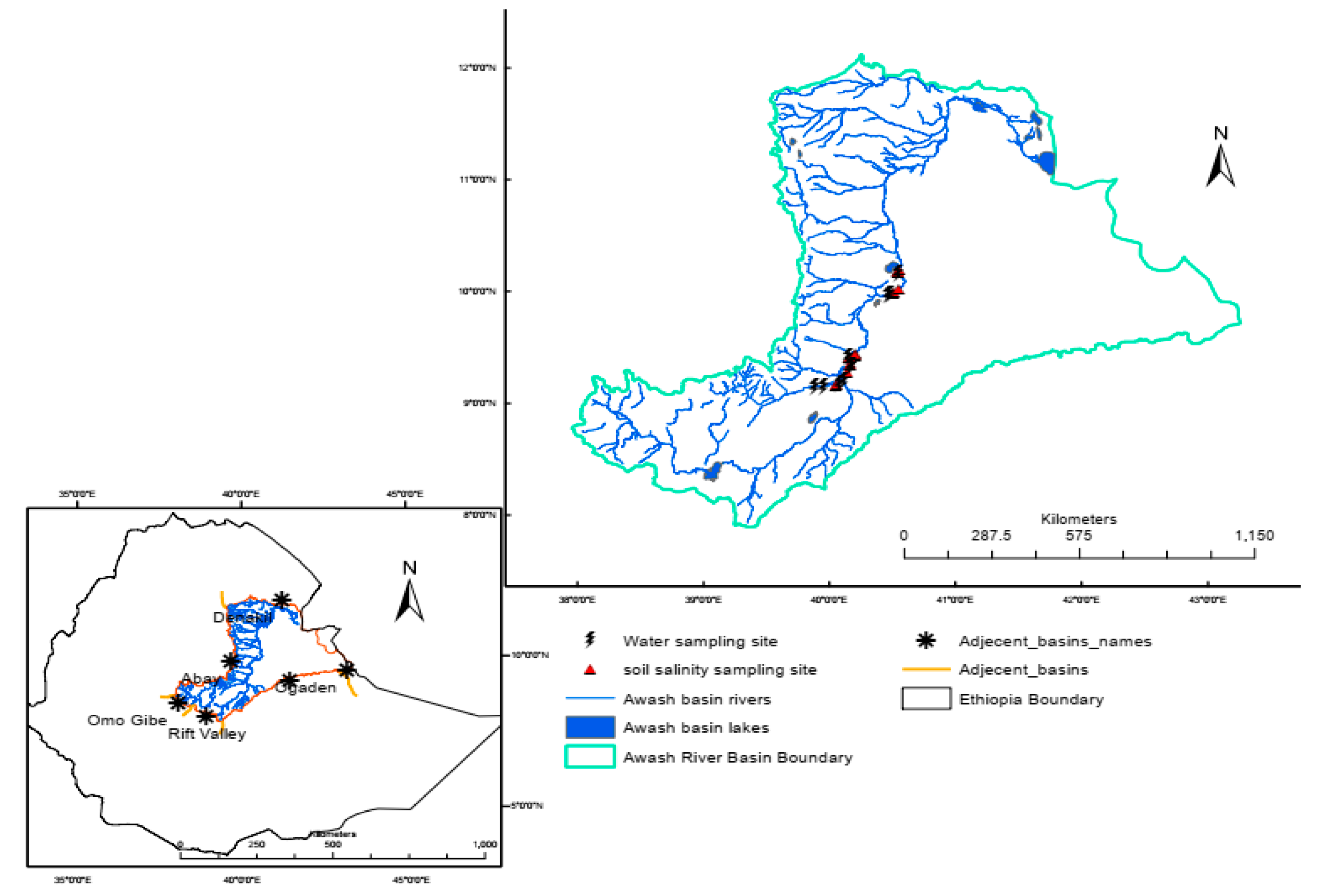

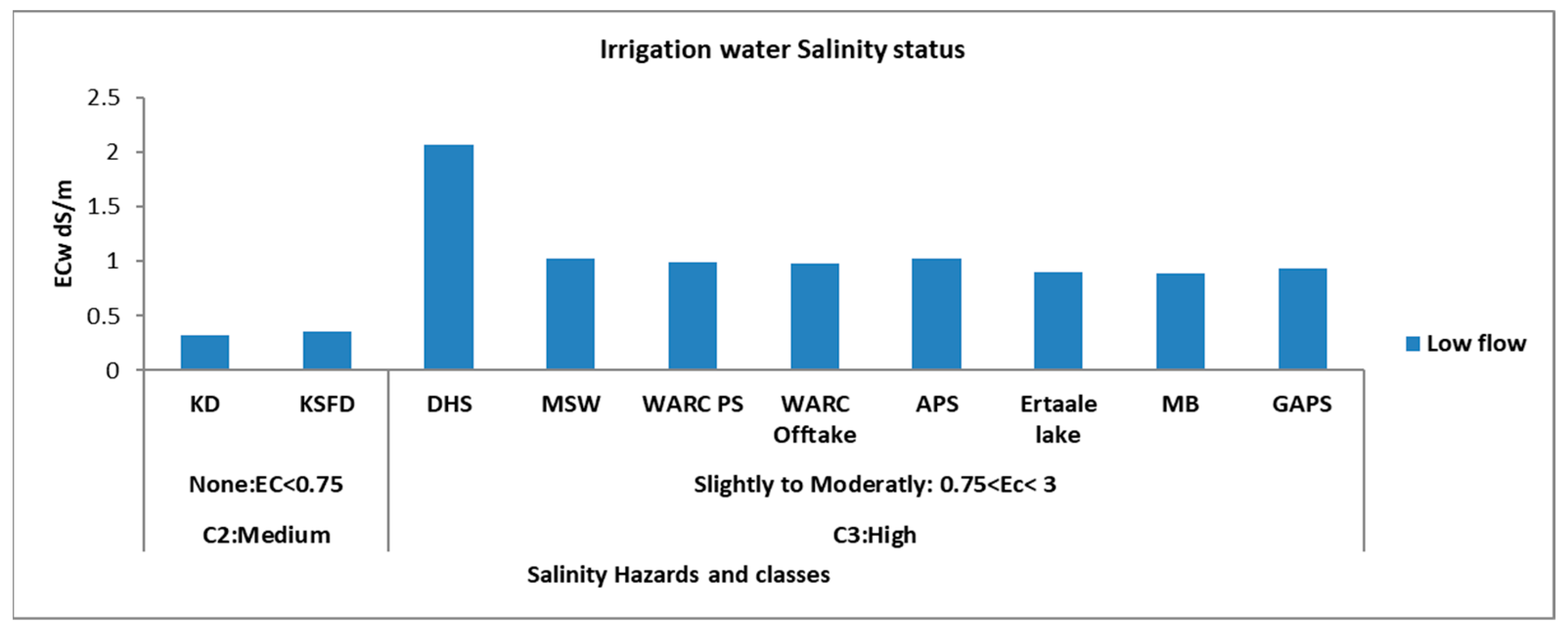
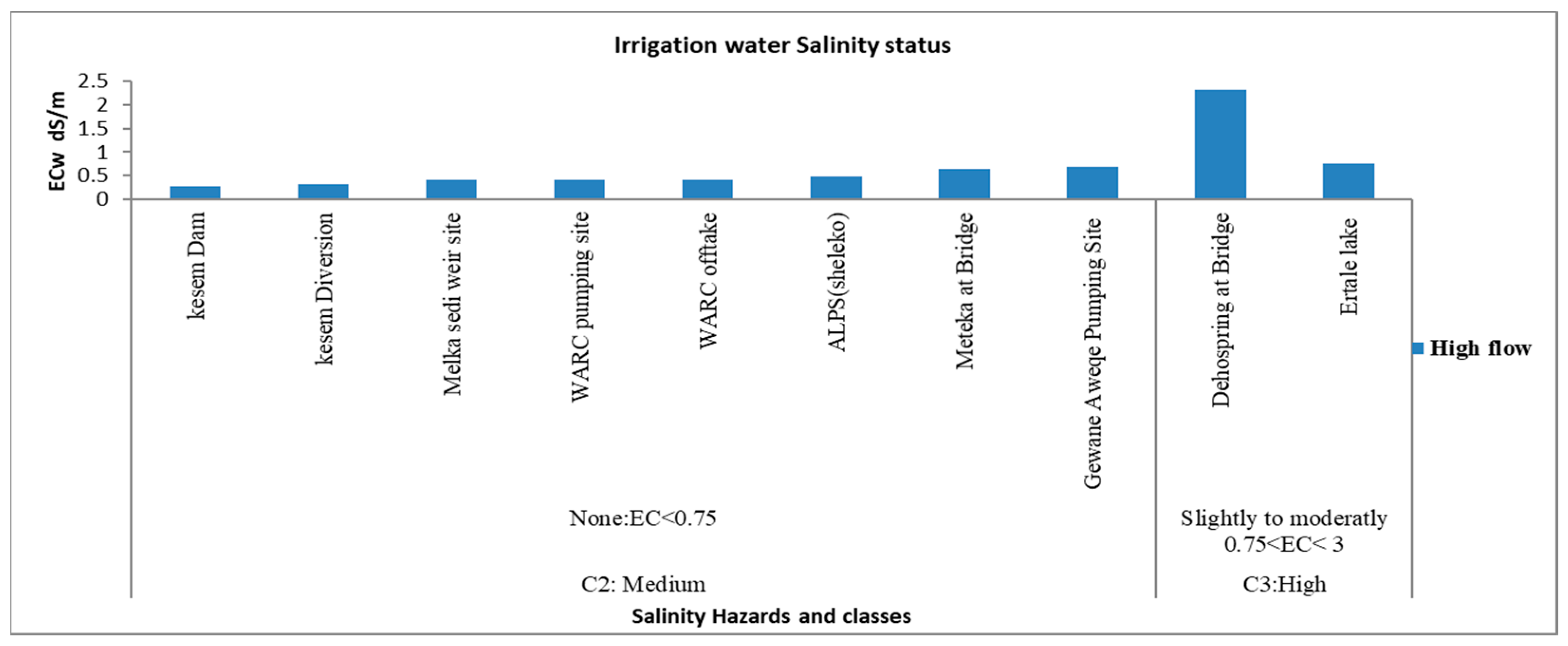
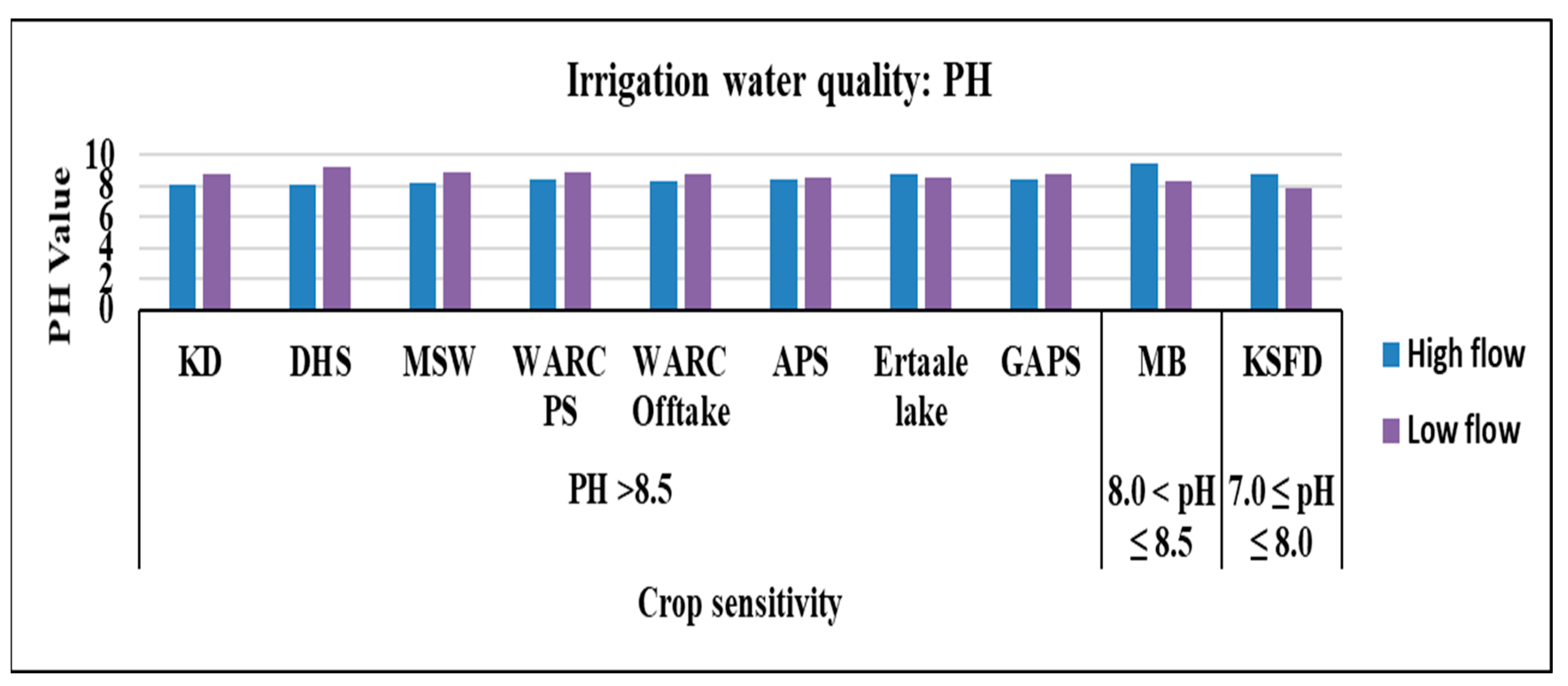

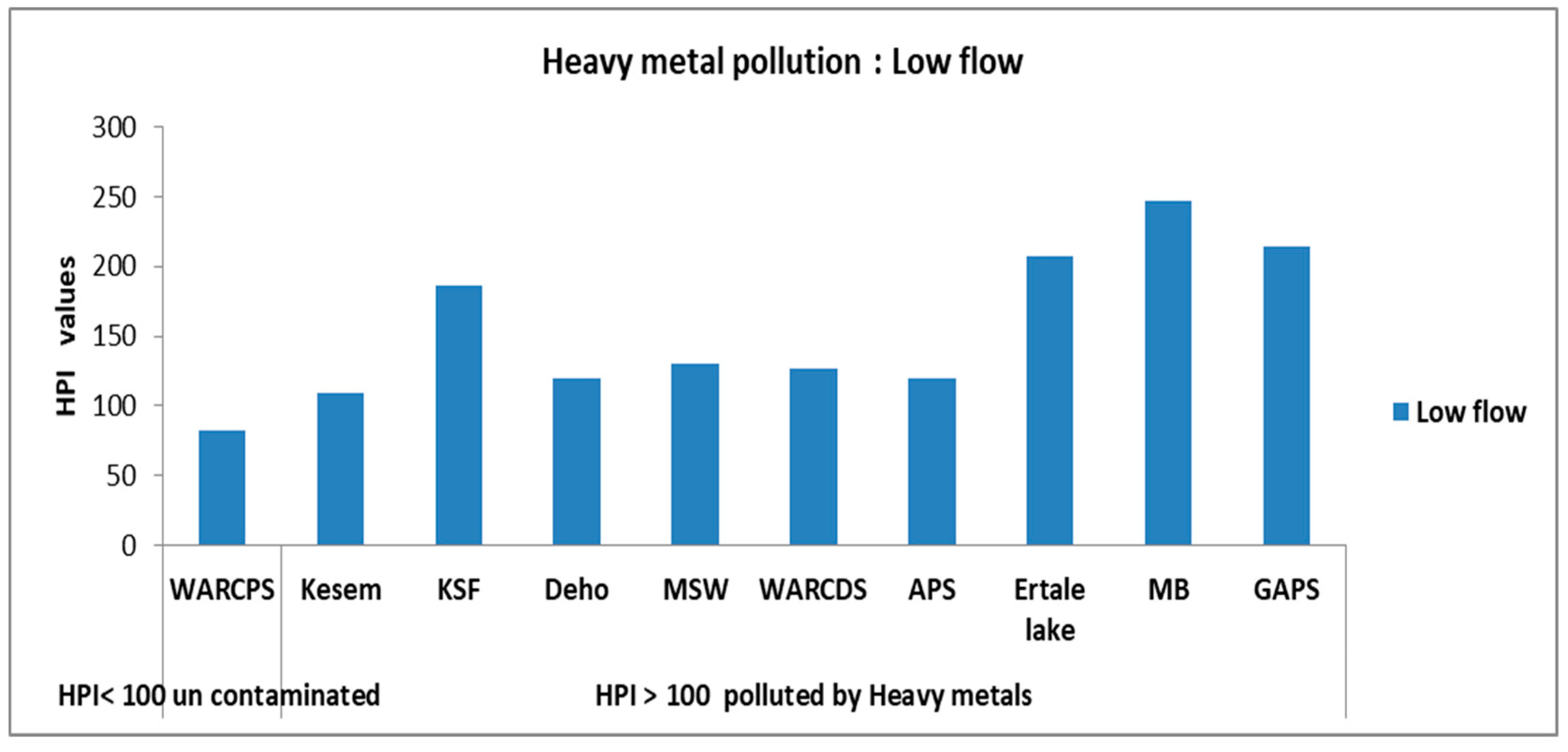

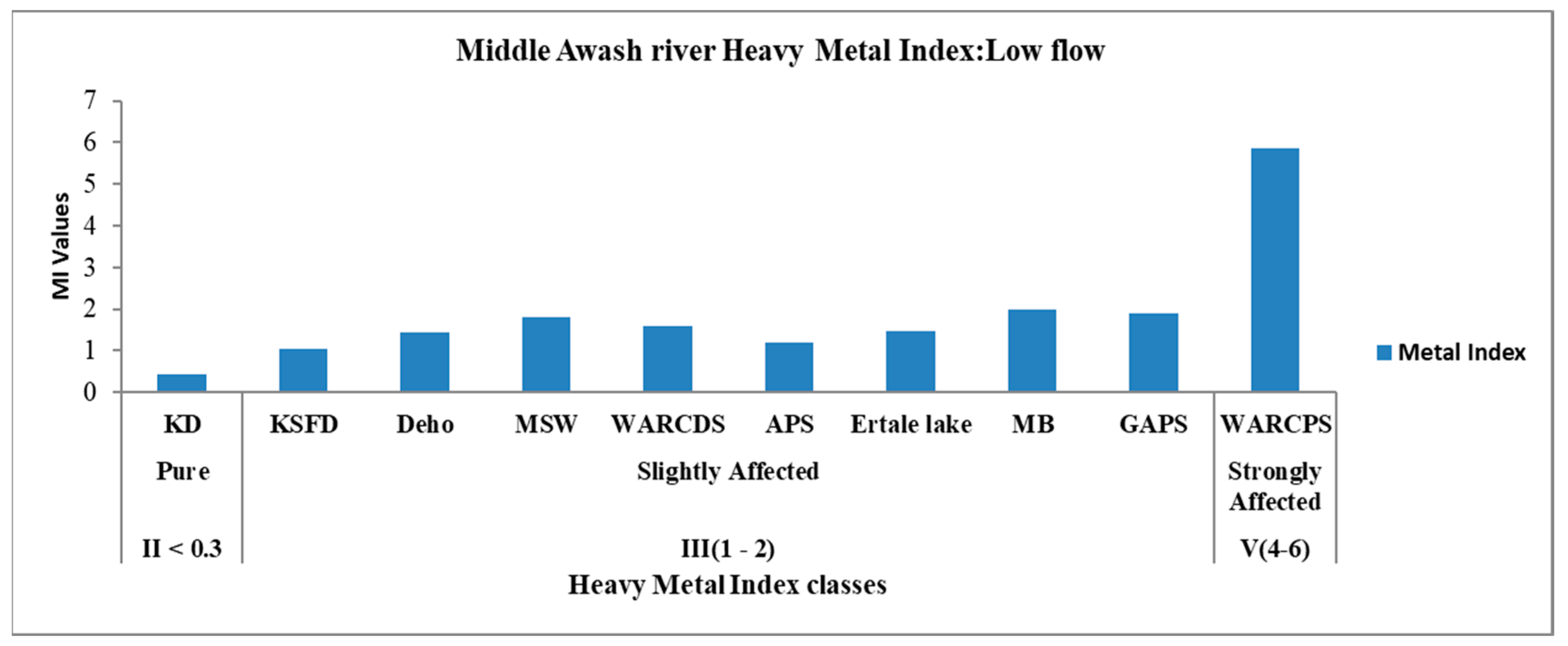
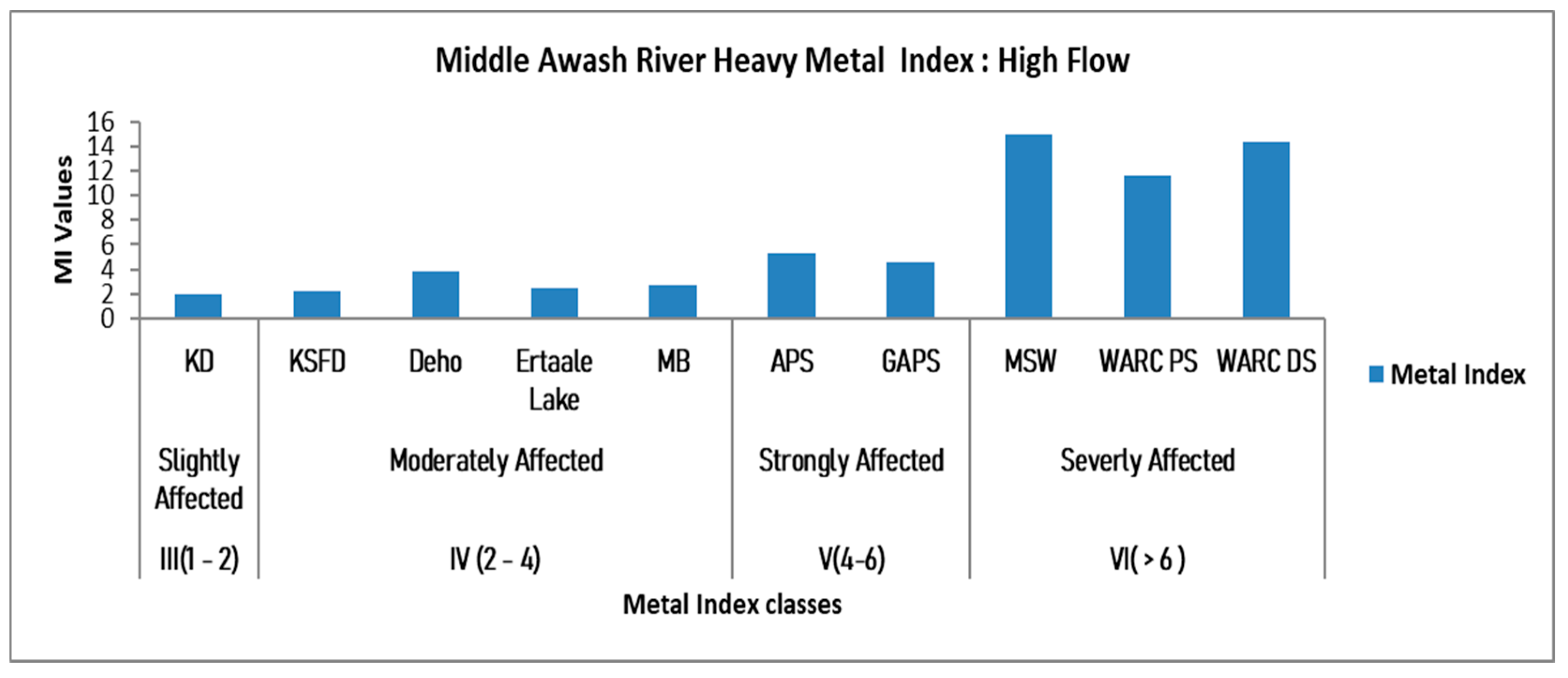
| Water Quality Indices | Range | Sodicity Class | Sodicity Hazard | Locations and Sampling Seasons | |
|---|---|---|---|---|---|
| Low Flow | High Flow | ||||
| Sodium Absorption Ratio (SAR) | <10 | S1 | Low | ALL | None |
| 10–18 | S2 | Medium | None | KD | |
| 18–26 | S3 | High | None | KSFD, MSW, WARC Offtake | |
| >26 | S4 | Very High | None | DHS, WARC PS, APS, Ertalale, MB, GAPS | |
| Residual Sodium Carbonate (RSC) | <1.25 | Safe | KD, KSF | KD, KSFD, MSW, WARC PS, WARC Offtake | |
| 1.25–2.5 | Marginal | None | APS, MB, GAPS | ||
| >2.5 | Unsuitable | DHS, MSW, WARC PS, WARC Offtake, APS, Ertalale, MB, GAPS | DHS, Ertaale Lake | ||
| Irrigation Water Quality (IWQ) Indices Crop Sensitivity | Parameter | Range | Hazard | Locations and Sampling Seasons | |
|---|---|---|---|---|---|
| Low Flow | High Flow | ||||
| PH | 7.0 ≤ pH ≤ 8.0 | Slight to moderate | KSFD | None | |
| 8.0 < pH ≤ 8.5 | Severe | Meteka | KD, KSFD, MSW, WARCPS, WARCD, APS, Meteka, and GAPS | ||
| pH > 8.5 | Highly severe | KD, DHS, MSW, WARCPS, WARCD, APS, Eratale Lake, and GAPS | DHS, Ertaale Lake | ||
| Nitrate Nitrogen (mg/L) | NO3− < 5.0 | None | KD, DHS, WARCPS, WARCD, and APS | None | |
| 5.0 ≤ NO3− ≤ 30.0 | Slight to moderate | None | KD, KSFD, and DHS | ||
| NO3− > 30.0 | Severe | KSFD, MSW, Ertaale Lake, Meteka, and GAPS | MSW, WARCPS, WARCD, APS, Ertaale Lake, and Meteka, GAPS | ||
| Alkalinity (mg/L) | Alkalinity < 90 | None | None | None | |
| 90 ≤ alkalinity ≤ 500 | Slight to moderate | KD, KSFD, MSW, WARCPS, WARCD, Ertaale Lake, Meteka, and GAPS | KD, KSFD, and Ertaale Lake | ||
| Alkalinity > 500 | Severe | DHS | DHS, MSW, WARCPS, WARCD, Ertaale Lake, and Meteka, GAPS | ||
| Locations | ER Low-Flow Season | ER High-Flow Season | ||||
|---|---|---|---|---|---|---|
| ER < 40 | 40 ≤ RI < 80 | Ecological Risk of Individual Metal | ER < 40 | 40 ≤ ER < 80 | Ecological Risk of Individual Metal | |
| Kesem | All | Low | All | Low | ||
| KSF | All except Cd | Cd: 68 | Moderate risk (Cd) | All | Low | |
| Deho | All | Low | All | Low | ||
| MSWeir | All except Cd and Hg | Low | All except Cd and Hg | Cd: 55.976 and Hg: 42.73 | Moderate risk | |
| WARCPS | All | Low | All | Low | ||
| WARCDS | All except Cd | Cd: 40 | Moderate risk (Cd) | All except Cd | Cd: 60.32 | Moderate risk |
| Ambash PS | All | Low | All | Low | ||
| Ertaale Lake | All except Cd | Cd: 76 | Moderate risk (Cd) | All | Low | |
| Meteka | All except Cd | Cd: 80 | Moderate risk (Cd) | All | Low | |
| Gewanie PS | All except Cd | Cd: 76 | Moderate risk (Cd) | All | Low | |
| Locations | RI Low-Flow Season | RI High-Flow Season | ||||
|---|---|---|---|---|---|---|
| RI < 112.5 | 112.5 ≤ RI < 225 | Ecological Risk of Single Metal | RI < 112.5 | 112.5 ≤ RI < 225 | Ecological Risk of Single Metal | |
| Kesem | 53.5 | Low | 2.49 | Low | ||
| KSF | 99.94 | Low | 25.76 | Low | ||
| Deho | 108.52 | Low | 110.1 | Low | ||
| MSWeir | 81.82 | Low | 149.81 | Moderate risk | ||
| WARCPS | 59.91 | Low | 110.76 | |||
| WARCDS | 80.91 | Low | 158.05 | Moderate risk | ||
| AmbashPS | 75.95 | Low | 73.38 | Low | ||
| Ertaale lake | 118.19 | Moderate | 54.78 | Low | ||
| Meteka | 136.95 | Moderate | 42.78 | Low | ||
| Gewanie PS | 122.093 | Moderate | 47.08 | Low | ||
Disclaimer/Publisher’s Note: The statements, opinions and data contained in all publications are solely those of the individual author(s) and contributor(s) and not of MDPI and/or the editor(s). MDPI and/or the editor(s) disclaim responsibility for any injury to people or property resulting from any ideas, methods, instructions or products referred to in the content. |
© 2025 by the authors. Licensee MDPI, Basel, Switzerland. This article is an open access article distributed under the terms and conditions of the Creative Commons Attribution (CC BY) license (https://creativecommons.org/licenses/by/4.0/).
Share and Cite
Hailu, E.K.; Agumassie, T.A.; Gebrehiwot, S.G.; Chukalla, A.D.; Charles, K.J. Spatial and Seasonal Water Quality and Heavy Metal Pollution for Irrigation Use in Awash River, Ethiopia. Water 2025, 17, 757. https://doi.org/10.3390/w17050757
Hailu EK, Agumassie TA, Gebrehiwot SG, Chukalla AD, Charles KJ. Spatial and Seasonal Water Quality and Heavy Metal Pollution for Irrigation Use in Awash River, Ethiopia. Water. 2025; 17(5):757. https://doi.org/10.3390/w17050757
Chicago/Turabian StyleHailu, Elias Kebede, Tena Alamirew Agumassie, Solomon Gebreyohannis Gebrehiwot, Abebe Demissie Chukalla, and Katrina Jane Charles. 2025. "Spatial and Seasonal Water Quality and Heavy Metal Pollution for Irrigation Use in Awash River, Ethiopia" Water 17, no. 5: 757. https://doi.org/10.3390/w17050757
APA StyleHailu, E. K., Agumassie, T. A., Gebrehiwot, S. G., Chukalla, A. D., & Charles, K. J. (2025). Spatial and Seasonal Water Quality and Heavy Metal Pollution for Irrigation Use in Awash River, Ethiopia. Water, 17(5), 757. https://doi.org/10.3390/w17050757










